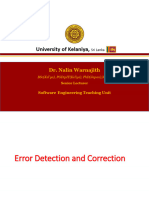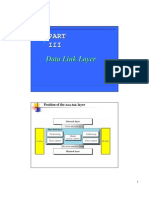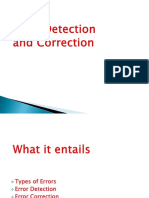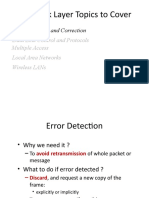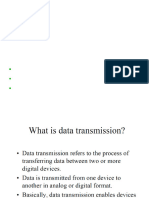0 ratings0% found this document useful (0 votes)
25 views08 Data Link LayerError Control
This document discusses error control in data communication and networking. It begins by explaining that errors during transmission are inevitable due to noise, interference and other factors. It then defines different types of errors like single bit errors and burst errors. Various error detection techniques are described such as parity checks, checksums, and cyclic redundancy checks. Finally, the document introduces error correcting codes like Hamming codes, which add enough redundant bits to allow for correction of errors in addition to just detecting them.
Uploaded by
saurabh singh gahlotCopyright
© © All Rights Reserved
Available Formats
Download as PPTX, PDF, TXT or read online on Scribd
0 ratings0% found this document useful (0 votes)
25 views08 Data Link LayerError Control
This document discusses error control in data communication and networking. It begins by explaining that errors during transmission are inevitable due to noise, interference and other factors. It then defines different types of errors like single bit errors and burst errors. Various error detection techniques are described such as parity checks, checksums, and cyclic redundancy checks. Finally, the document introduces error correcting codes like Hamming codes, which add enough redundant bits to allow for correction of errors in addition to just detecting them.
Uploaded by
saurabh singh gahlotCopyright
© © All Rights Reserved
Available Formats
Download as PPTX, PDF, TXT or read online on Scribd
You are on page 1/ 30
CAP275: Data Communication and Networking
Unit-3: Data Link Layer – Error Control
Error Control
Because of Attenuation, distortion, noise and interferences,
errors during transmission are inevitable, leading to
corruption transmitted bits.
Longer the frame size and higher the probability of single bit
error, lower is the probability receiving a frame without error.
Data can be corrupted during transmission. For reliable
communication, errors must be detected and corrected.
Error
When data is being transmitted from one machine to another,
it may possible that data become corrupted on its way. Some
of the bits may be altered, damaged or lost during
transmission. Such a condition is known as error.
Types of Errors
Single bit error: Only one bit gets
corrupted. Common in Parallel
transmission.
Burst error: More than one bit gets
corrupted very common in serial
transmission of data occurs when the
duration of noise is longer than the
duration of one bit.
Single bit error
The term single-bit error means that only one bit of given data
unit (such as a byte, character, or data unit) is changed from 1
to 0 or from 0 to 1 as shown in Fig.
Single bit errors are least likely type of errors in serial data
transmission.
For example, if 16 wires are used to send all 16 bits of a word at the same
time and one of the wires is noisy, one bit is corrupted in each word.
Burst error
More than one bit gets corrupted very common in serial
transmission of data occurs when the duration of noise is
longer than the duration of one bit.
The noise affects data; it affects a set of bits.
The number of bits affected depends on the data rate and
duration of noise.
Error Detection Techniques
Basic approach used for error detection is the use of redundancy, where
additional bits are added to facilitate detection and correction of errors.
Redundancy is the method in which some extra bits are added to the data so
as to check whether the data contain error or not. Popular techniques are:
Simple Parity check
Two-dimensional Parity check
Checksum
Cyclic redundancy check
An n-bit unit containing data and check-bits is often referred to as an n-bit
codeword.
n = (m + r).
where
m - data bits (i.e., message bits)
r - redundant bits (or check bits).
n - total number of bits
Simple Parity Check
The simplest and most popular error detection scheme.
Appends a Parity bit to the end of the data.
In parity check, a parity bit is added to every data unit so
that the total number of 1’s is even (or odd for odd-parity).
Suppose the sender wants to send the word world. In ASCII the
five characters are coded as
1110111 1101111 1110010 1101100 1100100
The following shows the actual bits sent
11101110 11011110 11100100 11011000 11001001
6 6 4 4 4
(6,6,4,4,)
Received without error
Now suppose the word in Example is received by the receiver without being
corrupted in transmission.
11101110 11011110 11100100 11011000 11001001
The receiver counts the 1s in each character and comes up with even numbers (6, 6,
4, 4, 4). The data are accepted.
Received with error
Now suppose the word world in Example 1 is corrupted during transmission.
11111110 11011110 11101100 11011000 11001001
The receiver counts the 1s in each character and comes up with even and odd
numbers (7, 6, 5, 4, 4). The receiver knows that the data are corrupted, discards
them, and asks for retransmission.
Performance of Simple Parity Check
Simple parity check can detect all single-bit error
It can also detect burst error, if the number of bits in even
or odd.
The technique is not foolproof against burst errors that
invert more than one bit. If an even number of bits is
inverted due to error, the error is not detected.
Two-Dimensional Parity Checking
Performance can be improved by using two dimensional parity
check, which organizes the block of bits in the form of table.
Parity check bits are calculated from each row, which is
equivalent to a simple parity check.
Parity check bits are also calculated for all columns.
Both row parity and column parity are
sent along with the data.
At the receiving end these are
compared with the parity bits
calculated on the received data.
Suppose the following block is sent:
10101001 00111001 11011101 11100111 10101010
However, it is hit by a burst noise of length 8, and some bits are
corrupted.
10100011 10001001 11011101 11100111 10101010
When the receiver checks the parity bits, some of the bits do not
follow the even-parity rule and the whole block is discarded.
10100011 10001001 11011101 11100111 10101010
Performance
If two bits in one data unit are damaged and two bits in
exactly same position in another data unit are also damaged,
The 2-D Parity check checker will not detect an error.
For example, if two data units: 11001100 and 10101100. If
first and second from last bits in each of them is changed,
making the data units as 01001110 and 00101110, the error
cannot be detected by 2-D Parity check.
CHECKSUM
In checksum error detection scheme, the data is divided into k
segments each of m bits.
At the sender’s end the segments are added using 1’s
complement arithmetic to get the sum.
The sum is complemented to get the checksum. The checksum
segment is sent along with the data segments.
At the receiver’s end the data unit is divided into k sections, each
of m bits.
All sections are added using one’s
complement to get the sum.
The sum is complemented. If the result is
zero, the data are accepted: otherwise,
rejected.
Suppose the following block of 16 bits is to be sent using a
checksum of 8 bits.
10101001 00111001
The numbers are added using one’s complement
10101001
00111001
------------
Sum 11100010
Checksum 00011101
The pattern sent is 10101001 00111001 00011101
Suppose the following block of 16 bits is to be sent
using a checksum of 8 bits.
10101001 00111001
The numbers are added using one’s complement
10101001
00111001
------------
Sum 11100010
Checksum 00011101
The pattern sent is 10101001 00111001 00011101
Now suppose there is a burst error of length 5 that
affects 4 bits.
10101111 11111001 00011101
When the receiver adds the three sections, it gets
10101111
11111001
00011101
Partial Sum 1 11000101
Carry 1
Sum 11000110
Complement 00111001 If the result is
non zero then the pattern is corrupted.
Cyclic Redundancy Check
One of the most powerful and commonly used error detecting
codes.
Given a m-bit block of bit sequence, the sender generates an n-bit
sequence known as frame sequence check (FCS), so that the
resulting frame, consisting of m+n bits exactly divisible by same
predetermined number.
The receiver divides the incoming frame by that number and, if
there is no reminder, assumes there was no error.
At Sender’s end
At receiver’s end
Note: Remainder is zero, no error. Receiver can accept the data.
Performance of CRC
CRC can detect all single-bit errors.
CRC can detect all double-bit errors(three1’s)
CRC can detect any odd number of errors of less than the
degree of the polynomial.
CRC detects most of the larger burst errors with a high
probability.
ERROR CORRECTING CODES
A single additional bit can detect error, but it’s not sufficient enough to correct that
error too.
For correcting an error one has to know the exact position of error, i.e. exactly
which bit is in error (to locate the invalid bits).
For example, to correct a single-bit error in an ASCII character, the error correction must determine
which one of the seven bits is in error. To this, we have to add some additional redundant bits.
To calculate the numbers of redundant bits (r) required to correct d data bits, let us
find out the relationship between the two. So we have (d+r) as the total number of
bits, which are to be transmitted; then r must be able to indicate at least d+r+1
different values.
Out of these, one value means no error, and remaining d+r values indicate error
location of error in each of d+r locations. So, d+r+1 states must be distinguishable
by r bits, and r bits can indicates 2r states. Hence, 2r must be greater than d+r+1.
2r >= d+r+1
The value of r must be determined by putting in the value of d in the relation. For example, if d is 7,
then the smallest value of r that satisfies the above relation is 4. So the total bits, which are to be
transmitted is 11 bits (d+r = 7+4 =11).
Hamming Code
A technique developed by R.W. Hamming provides a practical solution
to manipulate these bits to discover which bit is in error. The solution
or coding scheme he developed is commonly known as Hamming
Code.
Hamming code can be applied to data units of any length and uses the
relationship between the data bits and redundant bits
Number of Number of Total
data bits redundancy bits bits
m r m+r
1 2 3
2 3 5
3 3 6
4 3 7
5 4 9
6 4 10
7 4 11
Basic Approach
To each group of m information bits k parity bits are added
to form (m+k) bit code as shown in Fig. 3.2.8.
Location of each of the (m+k) digits is assigned a decimal
value.
The k parity bits are placed in positions 1, 2, …, 2 k-1
positions.
K parity checks are performed on selected digits of each
codeword.
At the receiving end the parity bits are recalculated. The
decimal value of the k parity bits provides the bit-position
in error, if any.
Calculation of Redundant Bits
You might also like
- 3 Merck & Company - Evaluating A Drug Licensing Opportunity PDF67% (3)3 Merck & Company - Evaluating A Drug Licensing Opportunity PDF28 pages
- Computer Communication & Networks: Datalink Layer: Error DetectionNo ratings yetComputer Communication & Networks: Datalink Layer: Error Detection33 pages
- Lecture 7 Error Detection and CorrectionNo ratings yetLecture 7 Error Detection and Correction41 pages
- Dr.M.Sushanth Babu - DCCN - Lecture NotesNo ratings yetDr.M.Sushanth Babu - DCCN - Lecture Notes62 pages
- 1 Error Detection and Correction Flow and Error ControlSliding Window Protocol 1683138001751 PDFNo ratings yet1 Error Detection and Correction Flow and Error ControlSliding Window Protocol 1683138001751 PDF47 pages
- Network Models & Error Detection and CorrectionNo ratings yetNetwork Models & Error Detection and Correction32 pages
- Chapter 3 Error Detection and CorrectionNo ratings yetChapter 3 Error Detection and Correction48 pages
- Unit 2 Topic 7 ERROR DETECTION AND CORRECTIONNo ratings yetUnit 2 Topic 7 ERROR DETECTION AND CORRECTION50 pages
- Data Link Layer Topics To Cover: Error Detection and CorrectionNo ratings yetData Link Layer Topics To Cover: Error Detection and Correction37 pages
- Assignment No. 3: Title: Lab Assignment On Unit II: (Use C/C++)No ratings yetAssignment No. 3: Title: Lab Assignment On Unit II: (Use C/C++)7 pages
- Module-3.1 Error Detection and CorrectionNo ratings yetModule-3.1 Error Detection and Correction37 pages
- Chapter 4 - Lecture-1 Error Detection and Hamming CodeNo ratings yetChapter 4 - Lecture-1 Error Detection and Hamming Code42 pages
- Lecture 13 Data Link Layer Error Detection MethodsNo ratings yetLecture 13 Data Link Layer Error Detection Methods13 pages
- Error Control, Digital Data Communication TechniqueNo ratings yetError Control, Digital Data Communication Technique44 pages
- Software Process and Their CharactersticsNo ratings yetSoftware Process and Their Characterstics36 pages
- Rankine Cycle: A Presentation By: AKASH SOOD100% (1)Rankine Cycle: A Presentation By: AKASH SOOD15 pages
- Recent Ielts Writing Task 2 Questions 2021 @Ielts Niner Nerds 7No ratings yetRecent Ielts Writing Task 2 Questions 2021 @Ielts Niner Nerds 78 pages
- Learning Task 3.3 - Lets Plot The PointsNo ratings yetLearning Task 3.3 - Lets Plot The Points3 pages
- 2024 Panganiban Campus Landuse Map Complexes2No ratings yet2024 Panganiban Campus Landuse Map Complexes21 page
- INDOROCK 2017 Paper - Storage of Crude Oil in Solution Mined Salt CavernsNo ratings yetINDOROCK 2017 Paper - Storage of Crude Oil in Solution Mined Salt Caverns10 pages
- Quiet Power - The Secret Strengths of Introverts (PDFDrive)50% (2)Quiet Power - The Secret Strengths of Introverts (PDFDrive)194 pages
- Three Decades of Strategic Management Research On M&As: Citations, Co-Citations, and TopicsNo ratings yetThree Decades of Strategic Management Research On M&As: Citations, Co-Citations, and Topics12 pages
- (Issued 1 Dec. 1973) C RD - C 36-7 3 C36No ratings yet(Issued 1 Dec. 1973) C RD - C 36-7 3 C363 pages
- P VI - C R M, D: ART Omplaints and Edress Echanism AND IrectoryNo ratings yetP VI - C R M, D: ART Omplaints and Edress Echanism AND Irectory26 pages
- Role For Human Reliability Analysis (HRA)No ratings yetRole For Human Reliability Analysis (HRA)28 pages
- 2021 SPM - Listening - Module Bahasa - InggerisNo ratings yet2021 SPM - Listening - Module Bahasa - Inggeris57 pages
- 3 Merck & Company - Evaluating A Drug Licensing Opportunity PDF3 Merck & Company - Evaluating A Drug Licensing Opportunity PDF
- Computer Communication & Networks: Datalink Layer: Error DetectionComputer Communication & Networks: Datalink Layer: Error Detection
- 1 Error Detection and Correction Flow and Error ControlSliding Window Protocol 1683138001751 PDF1 Error Detection and Correction Flow and Error ControlSliding Window Protocol 1683138001751 PDF
- Data Link Layer Topics To Cover: Error Detection and CorrectionData Link Layer Topics To Cover: Error Detection and Correction
- Assignment No. 3: Title: Lab Assignment On Unit II: (Use C/C++)Assignment No. 3: Title: Lab Assignment On Unit II: (Use C/C++)
- Chapter 4 - Lecture-1 Error Detection and Hamming CodeChapter 4 - Lecture-1 Error Detection and Hamming Code
- Lecture 13 Data Link Layer Error Detection MethodsLecture 13 Data Link Layer Error Detection Methods
- Error Control, Digital Data Communication TechniqueError Control, Digital Data Communication Technique
- Recent Ielts Writing Task 2 Questions 2021 @Ielts Niner Nerds 7Recent Ielts Writing Task 2 Questions 2021 @Ielts Niner Nerds 7
- INDOROCK 2017 Paper - Storage of Crude Oil in Solution Mined Salt CavernsINDOROCK 2017 Paper - Storage of Crude Oil in Solution Mined Salt Caverns
- Quiet Power - The Secret Strengths of Introverts (PDFDrive)Quiet Power - The Secret Strengths of Introverts (PDFDrive)
- Three Decades of Strategic Management Research On M&As: Citations, Co-Citations, and TopicsThree Decades of Strategic Management Research On M&As: Citations, Co-Citations, and Topics
- P VI - C R M, D: ART Omplaints and Edress Echanism AND IrectoryP VI - C R M, D: ART Omplaints and Edress Echanism AND Irectory










